The honey bee is so small. But the working of its body is so fascinating. There is so much going inside that tiny body.
They live in colonies and help each other to ensure survival by making reproduction happen. They are so set in their roles that, through evolution, their bodies have adapted to their assigned roles. Here’s an example, only worker bees have pollen baskets, and only the Queen Bee can reproduce, moreover, she only mates with the drone bees.
How exactly does this happen? How does their body aid them?
Read this article till the end to find out about the inner workings of a honeybee’s body and take a glimpse into the science of bees.
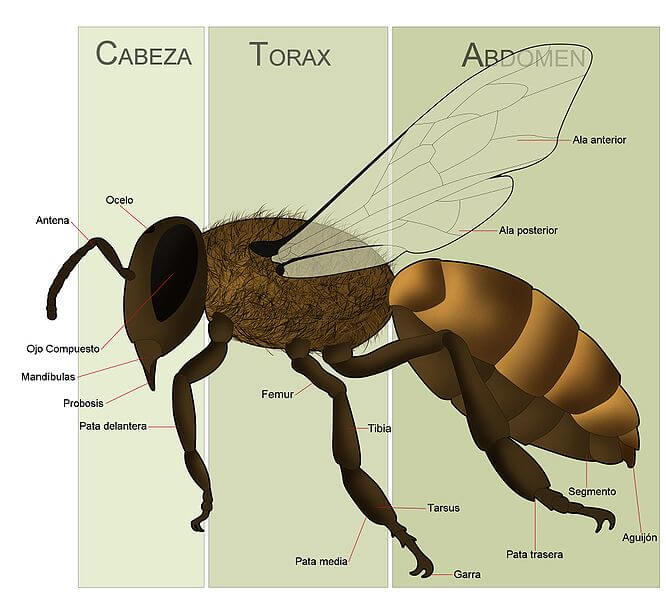
To begin with, here is a bee anatomy diagram.
The three main parts of a bee’s body : the head, the thorax, and the abdomen. This is similar to the parts of a bumblebee which is also divided into the same three sections.
The honey bee head: brain, antennas, mandibles, eyes, and tongue.
- The sensory part: brain and antennas
The head is home to the bee’s tiny brain. Much like our brain, it collects all external data and processes it.
The antennas on the bee’s head situated in the head wall allow it to avoid threats in the environment. The antennas can move in any direction.
Think about a bee’s antenna as your nose. The two antennas have thousands of tiny sensors that detect the smell. Bees will use them to differentiate floral and pheromone odors. The antennas also collect information about taste and touch.
The scout bee’s job is to seek out resources for the hive. So, its antennas will go in two different directions to pick up the smell of nectar.
The Johnston’s organs are a unique structure on the antenna which detects airflow. This determines how fast – and how far – the bee is flying. This is why bees clean their antennas before flying off to harvest pollen or nectar.
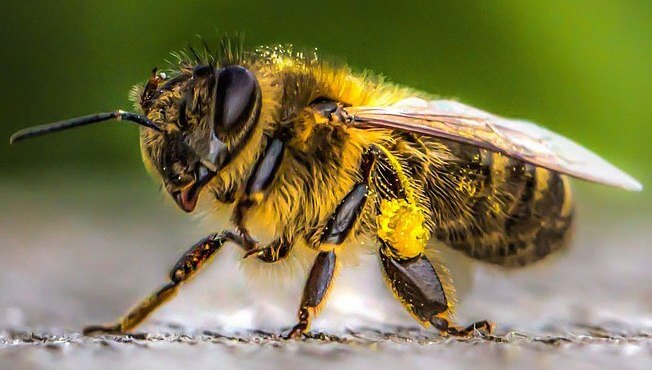
image credit: fortlewis.edu
- The bee’s mandibles
The mandibles are to a bee what your mouth is to you. These mouthparts let the bee both chew and suck. This functionality is achieved by the passion of both mandibles and a proboscis.
The mandibles can open and close to eat wood, manipulate wax, and bite other workers or pests. They can also be used to attack intruders, and delicately manipulate the wax into honeycombs.
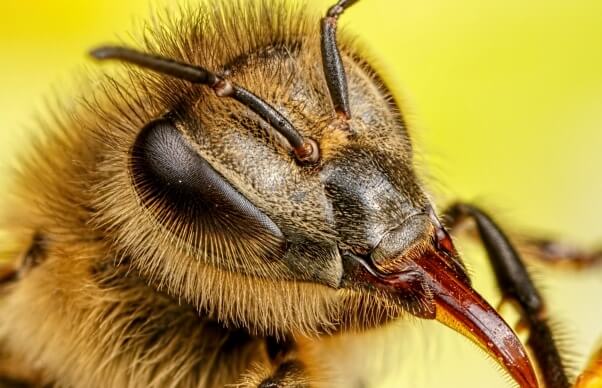
- The bee’s eyes
Honey bees have five eyes. Two eyes are large compound eyes that have several thousands of simple light-sensitive cells. The bees use them to distinguish light and color and gauge the general distance. This is why these creatures have furry little eyeballs.
In addition to these two compound eyes, they have three small simple eyes, called ocelli. Look closely at the top of their head. These three eyes are situated very close to each other.
They don’t see like us. We only see colors and not UV rays. These three eyes will collect UV light through a single lens. The bee uses this to see the location of pollen and land there. This feature is useful for worker bees while collecting pollen and nectar.
The drone bee’s eyes are much larger than those of the worker or queen bee, taking up a considerable part of the head’s overall volume. They assist him in locating the virgin queen during the mating flight as he pursues her.
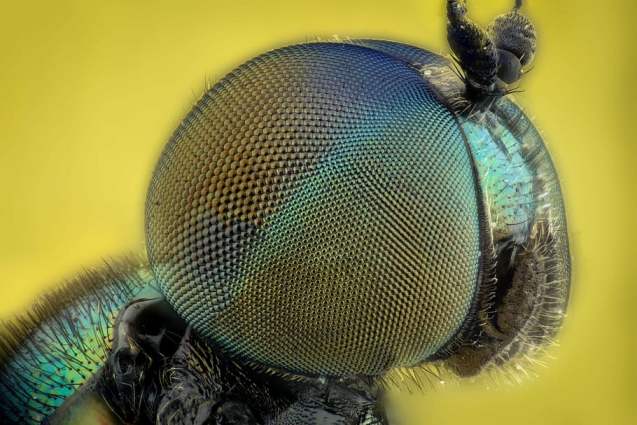
- The bee’s tongue
The proboscis situated in the bee’s head is its tongue. But unlike our tongue, it is not always functional. The maxillae and labium briefly join to form a tube that can draw up liquids like nectar, water, and honey.
Bees can only harvest from the flowers whose throat is shallow enough for their tongue to reach.
Apart from collecting nectar, bees will use their tongue to clean their hairs or to groom one another, similar to dogs or cats.
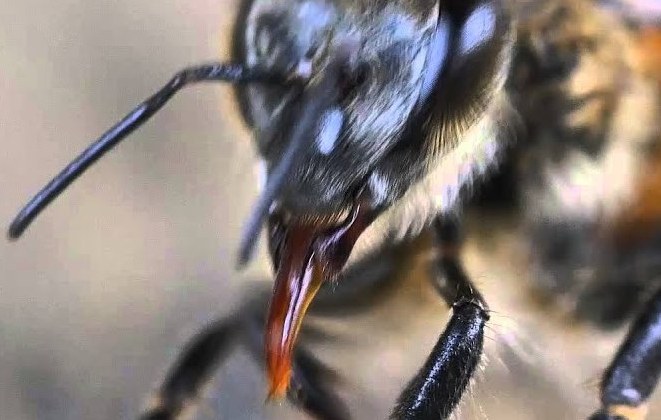
The thorax: two pairs of wings and three pairs of legs
The motion of the honey bee is reliant on the bee’s thorax.
- Wings
A honey bee has two wings on each side of its thorax; four wings in total. The hindwings are smaller.
The wings have three layers. The transparent membrane on the top and bottom is supported by a network of veins that transport hemolymph (bee “blood”). The veins also overcome air resistance in flight.
Although they can only fly up to 500 miles, their wings are so tiny, it is surprising they’re actually able to fly.
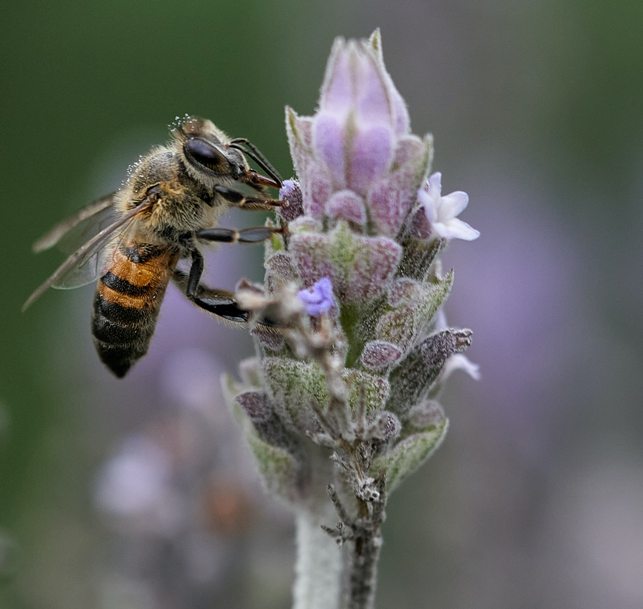
- Honey bee leg anatomy
A honey bee has a total of six legs, three on each side. Each pair of legs has a different function. And each leg has six segments, making these tiny creatures extremely flexible.
On the tips of the bees’ legs, you’ll see taste receptors. The bee cleans its antennae with its front-most legs.
The middle legs assist in walking and are used to load pollen into the pollen baskets on the hind legs. Male bees or the Queen bee do not have pollen baskets. This evolutionary feature is exclusive to worker bees as they have to forage for food.
The worker bee’s rear legs are specialized. The worker bee brushes, collects, packs, and transports pollen and back to the hive.
The joint of the honey bee’s knees helps them squeeze the pollen into little pellets which are then stored in the concave of the hind leg.
Here’s a honey bee leg diagram.
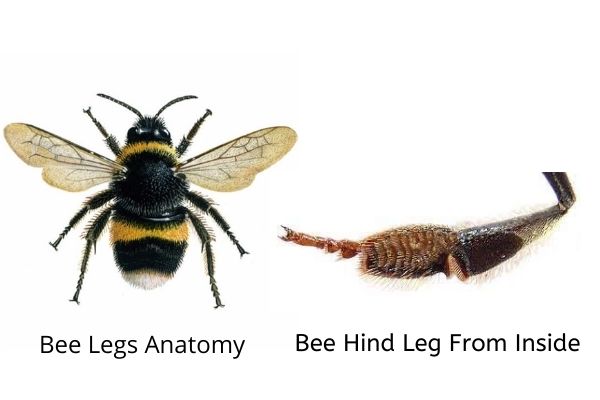
The bee abdomen: the stinger, wax glands, and reproductive organs
The abdomen of a honey bee holds the organs that control the digestive, circulatory, and reproductive functions.
- Wax glands
Only the worker bees have the wax and scent glands. Workers that are around 6-12 days old will produce wax scales with the help of their four pairs of wax glands. You can see the scales if you look carefully, they are thin and translucent.
The scent glands allow the worker bee to produce three main scents.
- The gland beneath the sting releases a unique pheromone that is sprayed around the sting site. Other workers are enticed to pursue and sting the victim by this odor.
- The same function is performed by a second alarm pheromone secreted by glands at the honey bee’s base of the mandibles.
- A third gland, located near the back of the abdomen, creates a pheromone that attracts swarms of other bees when discharged by scout bees.
- Stinger
The female worker bees and the Queen bee can sting you. The worker bee will try to get away after stinging you. The worker bee’s sting is barbed, hence, you cannot pull it out easily. Worker bees can sting you only once, as they’re most likely to die after. The queen does not have a barbed stinger.
These bees aren’t malicious creatures. You don’t have to be afraid of them or use aggressive measures to ensure that they don’t sting you. Bees only sting when they’re scared or hurt.
- The reproductive system – the Queen bee’s anatomy
A bee’s reproduction differs greatly from ours or any other mammals. Honey bees are social insects. All of them work together in a colony to facilitate reproduction and ensure survival.
Only the Queen bee can mate with the drones. Honey bees do not mate inside the colony. This is to prevent inbreeding within the same colony, which can lead to genetic defects. Hence, after she has turned into an adult, she will leave the hive to mate. Several worker bees often accompany her.
She will then mate with 8-12 drones in mid-air and at approximately a 25-meter height. During ejaculation, the drone bee squeezes his abdominal muscles, and his genitals come out. His genitals are later severed from his body, resulting in his death.
The “mating sign” occurs when parts of his genitals linger inside the queen’s vagina. They are removed by the next drone. Mating can take anywhere from 5 to 18 minutes.
The queen stores the entire spermatozoon in the spermatheca. Her gland secretes nutrients sufficient to sustain about 7,000,000 spermatozoa for the rest of her life. Hence, the Queen bee will decide whether or not to fertilize every egg that goes through her oviduct during egg-laying.
It is fascinating to think about how much choice a female bee has in the process of mating, unlike us humans.
The Queen bee can lay two types of eggs – fertilized and unfertilized. This determines the gender and role of the bee in the colony. Each of the honeycomb cells is measured by the queen bee. She will lay a fertilized egg in the cell if it is the size of a worker bee cell. However, if the cell is larger, the queen will lay an unfertilized egg.
The fertilized eggs will grow into female individuals. The unfertilized eggs will develop as male drones. After that, depending on their nutrition during the larval stage, the females can develop into queens or workers.
The potential queen bee is fed a special rich diet (royal jelly) which causes her to be sexually reproductive.
Each egg’s development into an insect takes a varying amount of time.
| Type of bee | Time taken to develop into an insect |
| Queen Bee | 16 days |
| Worker Bee | 21 days |
| Drone bee | 24 days |
The three components of the bee make up the basic bee anatomy.
Branched setae and the honey stomach of a worker bee – how do bees make honey
The worker bee is vital in two functions – pollination and honey making.
I had always wondered why bees looked like small, fluffy balls of happiness. I was not surprised to find out that these creatures are covered with feathery hairs called branches setae.
Worker bees use these hairs to collect pollen while foraging on flowers to collect nectar. This leads to cross-pollination. Collected pollen will be transferred to new plants.
The worker bee has a honey stomach which stores the collected nectar and bee saliva. The worker bees will pass the collected honey to house bees. The nectar will be chewed by each honey bee as it is passed on and the chemical property of the nectar changes making it honey. After this honey is dehydrated and stored.
Nature’s warning colors
The yellow and black stripes that we adore are meant to be a warning to other animals that bees can be dangerous. Some harmless flies have actually adopted these colors to trick predators into believing that they can be dangerous.
The tiny heart
Ever wondered how the complicated functions of the heart are carried out in such a tiny body? Here’s your answer.
Think of the heart as just a collection of musculated chambers joined by the aorta. The aorta travels from the abdomen to the head. Blood from the abdominal cavity enters the heart chambers through a small pore when the heart is relaxed.
When it contracts, the pore closes, forcing blood forward through the aorta to the brain. The blood then goes back through the thorax, supplying oxygen to all of the organs and muscle tissues along the route.
The study of bees is known as Melittology.
Bees live in a highly complex society. Their biology is greatly determined by the roles assigned to them. The net anatomy is proof that these little creatures have a sense of purpose just like us. And like us, they’re just trying to get by their day, doing what they’re supposed to.
Related Articles – Read More –